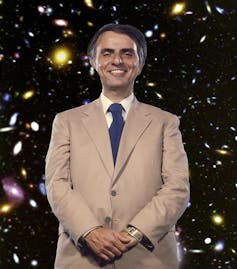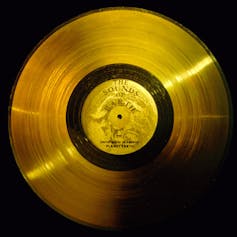On Nov. 9, 2024, the world will mark Carl Sagan’s 90th birthday – but sadly without Sagan, who died in 1996 at the age of 62.
Most people remember him as the co-creator and host of the 1980 “Cosmos” television series, watched worldwide by hundreds of millions of people. Others read “Contact,” his best-selling science fiction novel, or “The Dragons of Eden,” his Pulitzer Prize-winning nonfiction book. Millions more saw him popularize astronomy on “The Tonight Show.”
What most people don’t know about Sagan, and what has been somewhat obscured by his fame, is the far-reaching impact of his science, which resonates to this day. Sagan was an unequaled science communicator, astute advocate and prolific writer. But he was also an outstanding scientist.
Sagan propelled science forward in at least three important ways. He produced notable results and insights described in over 600 scientific papers. He enabled new scientific disciplines to flourish. And he inspired multiple generations of scientists. As a planetary astronomer, I believe such a combination of talents and accomplishments is rare and may occur only once in my lifetime.
Scientific accomplishments
Very little was known in the 1960s about Venus. Sagan investigated how the greenhouse effect in its carbon dioxide atmosphere might explain the unbearably high temperature on Venus – approximately 870 degrees Fahrenheit (465 degrees Celsius). His research remains a cautionary tale about the dangers of fossil fuel emissions here on Earth.

Carl Sagan hosted and co-wrote ‘Cosmos,’ a 13-part TV series that aired on PBS stations from 1980 to 1981.
Mickey Adair/Michael Ochs Archives/Hulton Archive via Getty Images
Sagan proposed a compelling explanation for seasonal changes in the brightness of Mars, which had been incorrectly attributed to vegetation or volcanic activity. Wind-blown dust was responsible for the mysterious variations, he explained.
Sagan and his students studied how changes to the reflectivity of Earth’s surface and atmosphere affect our climate. They considered how the detonation of nuclear bombs could inject so much soot into the atmosphere that it would lead to a yearslong period of substantial cooling, a phenomenon known as nuclear winter.
With unusual breadth in astronomy, physics, chemistry and biology, Sagan pushed forward the nascent discipline of astrobiology – the study of life in the universe.
Together with the research scientist Bishun Khare at Cornell University, Sagan conducted pioneering laboratory experiments and showed that certain ingredients of prebiotic chemistry, called tholins, and certain building blocks of life, known as amino acids, form naturally in laboratory environments that mimic planetary settings.




